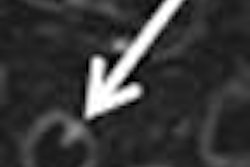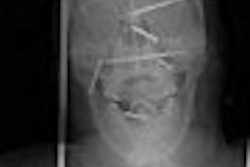With multislice CT technology evolving faster than anyone can keep pace or practice with, here is a much-needed primer on how to handle all the different parameters and coax the best performance from your scanner. And of course, whether and when you need all those fancy detector rows.
Practical guidelines for selecting detector width, pitch, and rotation speed were the subject of a talk at the recently concluded International Symposium on Multidetector-Row CT in San Francisco, U.S., by Dr Geoffrey D Rubin, associate professor and chief of cardiovascular imaging at the Stanford University School of Medicine.
In his talk, Rubin said that while higher pitch is perceived to cause more artifacts, this may not be true for all cases. It could, however, have an impact on high-contrast border scans. For example, in one case he demonstrated to meeting attendees, artifacts around the wall of the rectum will manifest to greater extent as the pitch increases.
But for the most part, artifact manifestations due to higher pitch are subtle, and do not have an impact on the diagnosis. “So I view the selection of the pitch as a very secondary, tertiary, quaternary consideration for how you are going to prescribe your scan,” he said.
Similarly, while table speed does have an impact, it is not a primary driver. Detector rows and detector thickness are also secondary considerations.
Scan time and scan distance
The most important considerations for prescribing a scan are the scan distance and scan time --in other words, the coverage and how long it will take. The rest of the parameters, such as the pitch and table speed, are adjusted accordingly based on these two considerations.
According to Rubin, the best way to think of CT protocoling is summarised in the expression:
Scan time = Distance x Rotation time / Pitch x Detector rows x Detector thickness
The scan time is particularly important when there is need for breath holding, and when respiratory motion is going to affect the quality of the images. In such cases, a higher scan speed and shorter scan time are critical. Scan time is also important to achieve consistency of organ and vascular enhancement, and, additionally, for multifaceted studies requiring reproducibility of organ and vascular enhancement.
More detector rows
Having more detector rows becomes important when the distance that needs to be covered by the scan is large. For short distances the number of detector rows is not very significant. If, for instance, you require 1-mm-thick sections for a 4-cm kidney, it can be done just as well with a four, 16, or 64-row scanner. But as the distance to be covered increases, the scan speed and scan time become more disparate, and the number of detector rows becomes more valuable.
As the number of detector rows increases from four to eight to 16, the minimum section thickness goes down substantially. So in a scanner with 16 rows or upward, all the sections are in effect only thin sections. And the best way to take advantage of a 16-row scanner is by using a volumetric approach and retrospectively reconstructing the thin sections. Scanning thin has obvious advantages -- for example, a pulmonary nodule on an 8-mm-thick section can be seen as a calcified nodule by retrospectively reconstructing thin sections.
“If you don’t interpret volumetrically, then there is little rationale for considering thinner sections,” Rubin said in his presentation. More detector rows and faster scans are important for applications such as CT angiography and motion-sensitive regions such as the thorax and, in particular, the heart.
For cardiac applications the pitch also has an impact. But scanners of 16-row (or upward) are so fast that there is no necessity for high-pitch scans. According to Rubin, scanning close to a pitch of 1 should, as a general rule, give the best image quality because the scan will still be very fast.
Rotation time
The rotation time has a direct impact on diagnostic scans relating to the heart. A fast rotation speed is critical to cardiac applications.
However, a reduced rotation speed is not without its uses. Longer rotation times can be used very effectively to reduce noise for low-contrast applications in large patients. By slowing down the gantry rotation and allowing more photons to get through the patient, noise can be minimized. This is also a useful technique when the body part being imaged is of greater thickness.
“Rotation speed is critical to cardiac applications, where we are trying to slow down the motion of the heart. But otherwise recognise that fast rotation speeds, while appealing for cardiac scans, can be your enemy for low-contrast applications in large patients,” Rubin said.
However, slowing down the gantry rotation also reduces the table speed. So if a lot of distance needs to be covered, it is not very practical to do so unless the scanner is of 16 rows or greater.
So in short, you need all those fancy detector rows when you want faster scans with the same minimal thickness, especially for your cardiac applications. And the best way to use them is to reconstruct with thin sections and interpret volumetrically. So go ahead and coax the best from your scanner!
By N. ShivapriyaAuntMinnieIndia.com staff writer
July 21, 2004
Copyright © 2004 AuntMinnie.com




















